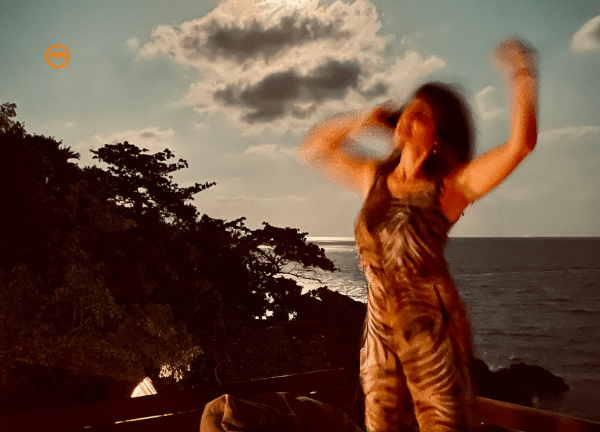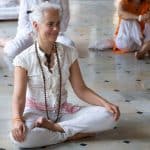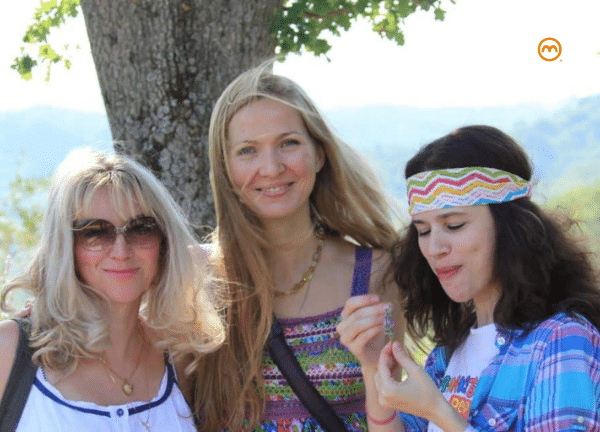
Female Energy – Mirror of Being
August 14, 2025I booked the retreat so I could finally stay with myself. That was my intention. “This time, I’m staying with myself.” After all, that’s what a meditation retreat is for. And I longed endlessly for inner peace. No sooner said than done.
I would like to accompany Mara together with you. She was with Madhukar on a silent retreat years ago when we were in Kißlegg. Currently, there is only one silent retreat. It takes place in India. But you can also turn an online retreat into a silent retreat for yourself at home. But first things first—I would like to accompany Mara together with you. I’ll let her continue:
Staying with myself—I book a retreat and resolve to stay with myself
Most of the participants had come there on recommendation. I had found it on the internet and had also carefully read the testimonials. I didn’t know exactly what to expect, which is why I was excited. The retreat was well organized, and I had all the information I needed to arrive there safely. We were asked to keep our cell phones turned off so we could immerse ourselves in the silence. Even though we just sat in silence, ate meals together without talking, and went on an autumn hike together, I felt comfortable.
When you decide to stay with yourself
“This time, I’m going to stay with myself.” That’s what I had decided before the retreat began. No cell phone, no communication, no distractions. Just silence, breathing, being.
And yet, as soon as I sat down on my cushion, I noticed my gaze wandering to the left and right. Did the others understand more? Were they doing it “right”?
Anyone who has ever tried to really stay with themselves knows how quickly we lose ourselves—in thoughts, in comparisons, in the subtle restlessness that arises from the attention of others.
What does it mean to “stay with myself”?
“Staying with yourself” does not mean isolating yourself or closing yourself off. It means maintaining contact with your own inner space – even when there is movement, stimulation or silence around us. It is the ability to direct your attention inward instead of losing it to the outside world. Psychologically speaking, it is self-contact. Physically: regulation. Spiritually: arrival. But this ability has to be learned – especially if you have spent your whole life paying attention to others because no one ever paid attention to you.
From the outside to the inside: an experience at the retreat
“I was afraid that the stimuli that I usually find hard to bear would overwhelm me again afterwards,” she said to me after the retreat. “But the opposite happened. My breath became my anchor.”
At first, Mara still compared herself to others – “Am I doing it right? Did I understand less than they did?” – but as the days went by, she felt these questions slowly fade away. Instead of paying attention to the others, she began to feel her own body. And the silence.
How the nervous system remembers
Her breath brought her back into her body. But it wasn’t just her breath. In the silence, memories surfaced. Old images in which she had felt small, insecure, and unprotected. A mother who was absent because she herself had no access to her own feelings. A feeling that lives on in many highly sensitive people: feeling responsible at an early age instead of feeling secure. During the retreat, Mara realized that her mother had not been there for her during her childhood because she was cold, but because she could not feel herself.
This understanding brought compassion.
And peace.
Learning to feel yourself – staying with me
After the retreat, she said: “I am not the epitome of calm – but I can perceive my physical reactions more quickly. I notice when my thoughts return to others. Then I breathe, and it becomes quiet.
“That’s the moment when staying with yourself begins. Not when you’re perfectly centered, but when you notice that you’re not – and return.
Why we lose ourselves – and how we return home
Many of us learned to feel others before we could feel ourselves. We oriented ourselves: by looks, expectations, moods. The nervous system has taken over. It is still looking for security outside ourselves – even though it has long been within us. Staying with yourself means recognizing this old movement and giving it a new direction: inward. To where the breath rests. Deeper than that, it lies in this moment.
Staying with myself in relationship and silence
On the last evening of the retreat, Mara sat at the table with the others. Again, that uncertainty. Again, the comparison. They were allowed to talk to each other again. And then – after a while – her breath returned. She felt herself. Her breath and the silence had helped her to stay focused on herself, and not lose herself in the others. She had never managed that before and without effort.
Now I would like to take a little detour. This is about Advaita.
What does that mean? In a deeper sense, “staying with myself” does not mean the person who thinks, feels, or reacts. From the Advaita perspective, this self to which we want to return is itself only a thought in consciousness. What we call “being with myself” is ultimately what was never lost: pure awareness, in which thoughts, body, and feelings appear and disappear. When this realization flashes, it becomes clear: you cannot not be with yourself. You are the consciousness in which everything happens. So much for the theory.
Transformation: From comparison to “being with myself” and thus to inner peace
What began as a search ended in a deep sense of gratitude.
“I am proud that I dared to do it. I feel free. I can stay with myself, even when others are around me.” Mara understood: staying with yourself is not a technique, but an attitude. A constant returning. A loving remembrance of what is still within us.
Conclusion: Coming home to yourself “Staying with myself” means being connected with myself in the midst of life. Not perfect, but awake. The breath as an anchor, feeling as a path. When you realize that you are losing yourself in the outside world again, it is not a mistake, but an invitation: Return. To where you already are.
If you feel that you often live externally, in your thoughts, relationships, responsibilities, and would like to learn to feel yourself again, then I invite you to come to the Silence Retreat in India, or try out the Self-Love Retreat. It is available online or on-site. Discover how silence teaches you to stay with yourself.
Advaita describes what is always true at a deep level. Pure being beyond the person who can come and go, feel and react. The retreat, on the other hand, is the practice in which this knowledge is embodied: by becoming still, feeling, breathing, and experiencing how attention returns home.
This is how theory and experience meet.
Advaita is understanding, the retreat is experiencing what already is.
Want to try it out? Come to the retreat and see if what I promise here is true.
Hi, I’m Shivani
Blogger and podcaster at Madhukar Enlighten Life. I’ve known Madhukar since 2004 and do what I can to ensure that his effective message of happiness reaches as many people as possible. This post came from my pen – and ChatGpt helped me a little.






